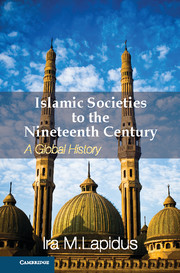Book contents
- Frontmatter
- Contents
- List of Illustrations
- List of Figures
- List of Maps
- List of Tables
- Preface
- Acknowledgments
- Acknowledgments to the first edition of A History of Islamic Societies
- Acknowledgments to the second edition of A History of Islamic Societies
- Publisher's Preface
- Introduction to Islamic Societies
- Part I The Beginnings of Islamic Civilizations
- The Middle East from c. 600 TO c. 1000
- The Preaching of Islam
- The Arab-Muslim Imperium (632–945)
- Chapter 5 Introduction to the Arab-Muslim Empires
- Chapter 6 The Arab-Muslim Conquests and the Socioeconomic Bases of Empire
- Chapter 7 Regional Developments: Economic and Social Change
- Chapter 8 The Caliphate to 750
- Chapter 9 The ʿAbbasid Empire
- Chapter 10 Decline and Fall of the ʿAbbasid Empire
- Cosmopolitan Islam: The Islam of The Imperial Elite
- Urban Islam: The Islam of Scholars and Holy Men
- Women, Families, and Communities
- Part II From Islamic Community to Islamic Society
- Part III The Global Expansion of Islam from the Seventh to the Nineteenth Centuries
- Glossary
- Bibliography
- Annotated Bibliography from A History of Islamic Societies, 2nd Edition
- Index
Chapter 6 - The Arab-Muslim Conquests and the Socioeconomic Bases of Empire
Published online by Cambridge University Press: 05 February 2013
- Frontmatter
- Contents
- List of Illustrations
- List of Figures
- List of Maps
- List of Tables
- Preface
- Acknowledgments
- Acknowledgments to the first edition of A History of Islamic Societies
- Acknowledgments to the second edition of A History of Islamic Societies
- Publisher's Preface
- Introduction to Islamic Societies
- Part I The Beginnings of Islamic Civilizations
- The Middle East from c. 600 TO c. 1000
- The Preaching of Islam
- The Arab-Muslim Imperium (632–945)
- Chapter 5 Introduction to the Arab-Muslim Empires
- Chapter 6 The Arab-Muslim Conquests and the Socioeconomic Bases of Empire
- Chapter 7 Regional Developments: Economic and Social Change
- Chapter 8 The Caliphate to 750
- Chapter 9 The ʿAbbasid Empire
- Chapter 10 Decline and Fall of the ʿAbbasid Empire
- Cosmopolitan Islam: The Islam of The Imperial Elite
- Urban Islam: The Islam of Scholars and Holy Men
- Women, Families, and Communities
- Part II From Islamic Community to Islamic Society
- Part III The Global Expansion of Islam from the Seventh to the Nineteenth Centuries
- Glossary
- Bibliography
- Annotated Bibliography from A History of Islamic Societies, 2nd Edition
- Index
Summary
The Conquests
With the death of the Prophet Muhammad, a new era began, an era of vast conquests and the formation of a Middle Eastern–wide Arab-Islamic empire. The Arab-Muslim conquests began the processes that culminated in the formation of a new empire, which included all of the former Sasanian Empire and much of the Byzantine Empire, and in the emergence in that geographic and political framework of Islamic cultures and societies.
When Muhammad died in 632, he left no instructions concerning succession, and, in the absence of an agreement with regard to a successor, the Muslim community – a conglomeration of diverse elements – was on the verge of disintegrating. To prevent this, some of the tribes and factions elected Abu Bakr – one of Muhammad's closest associates and his father-in-law – as caliph or successor. Abu Bakr was the first of those who were later identified as the Rashidun, the Rightly Guided Caliphs: Abu Bakr (632–34), ʿUmar (634–44), ʿUthman (644–56), and ʿAli (656–61), who ruled by virtue of their personal connections with Muhammad and Arabian ideas of authority. The conquests made the caliphs the rulers of the newly conquered lands as well.
- Type
- Chapter
- Information
- Islamic Societies to the Nineteenth CenturyA Global History, pp. 58 - 65Publisher: Cambridge University PressPrint publication year: 2012



